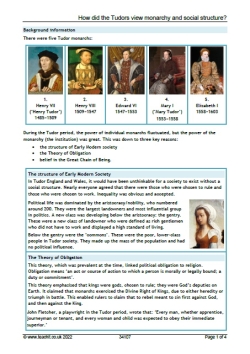How did the Tudors view monarchy and social structure?
In this engaging A-level resource, students read a summary of how the power of the monarchy in Tudor England was upheld by:
- the structure of Early Modern society
- the Theory of Obligation and the Divine Right of Kings
- belief in the Great Chain of Being.
They then rank various members of society (nobility, labourers, yeomen, the Pope, vagrants, God, gentry, the King, churchmen) according to the hierarchy of the Great Chain of Being, noting that women would always be below their male counterparts within the same rank.
Finally, they write an answer to the question 'Which of the three social theories described in the background information do you think would be the most helpful in reinforcing the monarch's power? Justify your opinion.'
An extract from the text:
The Great Chain of Being was a western medieval and Early Modern conception of the order of the universe whose chief characteristic was a strict hierarchical system. It expressed a belief in a social orders where all had their place and role. Themes of loyalty and obligation applied downwards as well as upwards. All in the chain had responsibilities.

